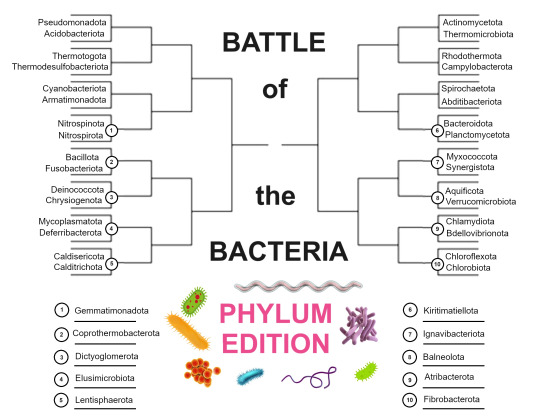Text
The first part of the first round of @bacteriashowdown begun a few days ago and is underway! Here’s your chance to go learn and vote for the phyla of the kingdom that we lost way too soon in the kingdom battles!
Phylum Bracket Announcement!

42 bacterial phyla, from two sources: Oren & Garrity (2021), and the list of recognized bacterial phyla under the ICNP as of February 2024. The Oren & Garrity list is more expansive, as it includes bacterial phyla that have been well studied, but not cultivated in the lab, while the ICNP restricts itself to bacteria that have been successfully cultured. 36 phyla were on both lists, 4 were exclusive to Oren & Garrity, and 2 were exclusive to the ICNP. Two phyla from the Oren & Garrity list were excluded for not being bacteria, as the list was of prokaryotic phyla generally.
The first round will be between 32 of the phyla, while ten sit out. Then the second round, which will be called round 1.5, will pair ten of the winners from the first round against those ten. Thus, after round 1.5, there will be 16 bacterial phyla remaining, and the tournament proceeds as is standard from there.
Here is a list of the phyla, organized (roughly) by clade and superphylum. Clades/superphyla are in bold and phylum names are in italics for clarity.
Terrabacteria
Abditibacteriota
Actinomycetota
Armatimonadota
Bacillota
Chloroflexota
Cyanobacteria
Mycoplasmatota
Thermomicrobiota
Hydrobacteria
Elusimicrobiota
Spirochaetota
Proteobacteria
Acidobacteriota
Aquificota
Bdellovibrionota
Campylobacterota
Chrysiogenota
Deferribacterota
Myxococcota
Nitrospinota
Nitrospirota
Pseudomonadota
Thermodesulfobacteriota
PVC Group
Chlamydiota
Lentisphaerota
Kirimatiellota
Planctomycetota
Verrucomicrobiota
FCB Group
Bacteroidota
Balneolota
Chlorobiota
Fibrobacterota
Gemmatimonadota
Ignavibacteriota
Rhodothermota
Thermotogida
Synergistida
Atribacterota
Synergistota
Thermocalda
Caldisericota
Calditrichota
Coprothermobacterota
Dictyoglomerota
Thermotogota
Other
Deinococcota
Fusobacteriota
Propaganda is still underway, but look out for an announcement of the first battles soon! I am planning to do round 1 in two parts over two weeks, with 8 battles in each week. Get ready: the girls are fighting !!!
#mod ranch#i wanted to promote this on this blog too but i sadly forgot ^^’ no more! this bracket is super cool!
66 notes
·
View notes
Text
THE FINAL IS OVER
WE HAVE A WINNER!
congratulations to Basidiomycota!
we now move on to the Class bracket. once again, we ask that you're patient with us as we do research into the most up to date classes for your poll clicking pleasure
51 notes
·
View notes
Text
THE PHYLA FINAL IS HERE

as with the kingdom final, no propaganda from us. you all know these two groups, now its just a choice between which one you want to see for the classes
308 notes
·
View notes
Text
as the final nears an end, i would just like to credit the main source of our information about fungi (there are other sources including many papers and articles), but this is the most significant. during the beginning of our research, we contacted a few mycologists and only one truly replied back.
Dr David moore is a retired mycologist/researcher, and i reached out to him asking for help. turns out, he has an online book that is very up-to-date (as of 2021)
you can get it here for free, or purchase the entire pdf for $30, or individual chapters for $5. once this poll has finished i will be updating him as to which phyla wins

this notification is one of my greatest achievements
#fungi#not sponsored as much as it reads like it is#hes a very nice guy#the battle of the taxons#final#phyla#David Moore#mod eddie
99 notes
·
View notes
Text
Phylum Bracket Announcement!

42 bacterial phyla, from two sources: Oren & Garrity (2021), and the list of recognized bacterial phyla under the ICNP as of February 2024. The Oren & Garrity list is more expansive, as it includes bacterial phyla that have been well studied, but not cultivated in the lab, while the ICNP restricts itself to bacteria that have been successfully cultured. 36 phyla were on both lists, 4 were exclusive to Oren & Garrity, and 2 were exclusive to the ICNP. Two phyla from the Oren & Garrity list were excluded for not being bacteria, as the list was of prokaryotic phyla generally.
The first round will be between 32 of the phyla, while ten sit out. Then the second round, which will be called round 1.5, will pair ten of the winners from the first round against those ten. Thus, after round 1.5, there will be 16 bacterial phyla remaining, and the tournament proceeds as is standard from there.
Here is a list of the phyla, organized (roughly) by clade and superphylum. Clades/superphyla are in bold and phylum names are in italics for clarity.
Terrabacteria
Abditibacteriota
Actinomycetota
Armatimonadota
Bacillota
Chloroflexota
Cyanobacteria
Mycoplasmatota
Thermomicrobiota
Hydrobacteria
Elusimicrobiota
Spirochaetota
Proteobacteria
Acidobacteriota
Aquificota
Bdellovibrionota
Campylobacterota
Chrysiogenota
Deferribacterota
Myxococcota
Nitrospinota
Nitrospirota
Pseudomonadota
Thermodesulfobacteriota
PVC Group
Chlamydiota
Lentisphaerota
Kirimatiellota
Planctomycetota
Verrucomicrobiota
FCB Group
Bacteroidota
Balneolota
Chlorobiota
Fibrobacterota
Gemmatimonadota
Ignavibacteriota
Rhodothermota
Thermotogida
Synergistida
Atribacterota
Synergistota
Thermocalda
Caldisericota
Calditrichota
Coprothermobacterota
Dictyoglomerota
Thermotogota
Other
Deinococcota
Fusobacteriota
Propaganda is still underway, but look out for an announcement of the first battles soon! I am planning to do round 1 in two parts over two weeks, with 8 battles in each week. Get ready: the girls are fighting !!!
66 notes
·
View notes
Note
Which phylum comprises more of the microrhizal network? That is a major factor in my decision.
Both form mycorrhizal relationships with plants, but they seem to be more common in basidiomycota
(x) (x)
8 notes
·
View notes
Text
Basidiomycota propaganda!
THE PHYLA FINAL IS HERE

as with the kingdom final, no propaganda from us. you all know these two groups, now its just a choice between which one you want to see for the classes
308 notes
·
View notes
Text
something about your body decomposes but your soul decomposes too. something about fungi returning your spirit to soil. something about returning to God by the handwork of scavenger beings, millions of years on this Earth. something about animals only being able to move onto land because of fungi. something about angels, warriors of God. something something something i am built out of the essences of corpses carried by mushrooms into unity with the Divine and shall return and return and return again.
111 notes
·
View notes
Text
Counting this as propaganda, too. Ascomycota propaganda!
THE PHYLA FINAL IS HERE

as with the kingdom final, no propaganda from us. you all know these two groups, now its just a choice between which one you want to see for the classes
308 notes
·
View notes
Text
Propaganda?
THE PHYLA FINAL IS HERE

as with the kingdom final, no propaganda from us. you all know these two groups, now its just a choice between which one you want to see for the classes
308 notes
·
View notes
Text
THE PHYLA FINAL IS HERE

as with the kingdom final, no propaganda from us. you all know these two groups, now its just a choice between which one you want to see for the classes
308 notes
·
View notes
Text
ROUND THREE IS OVER!
Ascomycota and Basidiomycota move on to the finals! A tough match for sure
9 notes
·
View notes
Text
PHYLA: ROUND THREE

Propaganda under here:
ASCOMYCOTA
The most species rich of all the phyla, species number estimates are anywhere from 30 000 to even 110 000. Many multicellular members of Ascomycota, or sac fungi, are best identified via their fruiting bodies on which microscopic spore-bearing cells called asci rest (though some reproduce asexually instead). They can be unicellular or form large complex structures, and fill all sorts of niches, ranging from mutualists to pathogens to decomposers. Most well-known sac fungi include most species of lichen, the common yeast, truffles and cordyceps.
OLPIDIOMYCOTA
A phylum with a single class, these fungi are also zoosporic, which means their spores are flagellated and capable of movement. Members of Olpidiomycota are pathogens, and can even serve as vectors for plant viruses. Once the hosts are infected, the fungi create spherical zoosporangia, the structure that produces more zoospores, inside their host's cells. These fungi are found in both terrestrial and aquatic environments alike and are still somewhat mysterious to science.
80 notes
·
View notes
Text
PHYLA: ROUND THREE

Propaganda under here:
BASIDIOMYCOTA
These are one of the main groups of fungi that everyone knows! They're best identified by their fruiting bodies, on which their microscopic spore-producing structures, basidia, rest on. Basidiomycota makes up 1/3 of all fungi with 32 000 described species, and they're both terrestrial and aquatic! Some fungi in this group can be mutualistic with insects, some contribute to rot and degredation of lignin in wood, and some (P. ostreatus) are carnivourous and eat nematodes! And most importantly, many are edible or have medicinal qualities.
ZOOPAGOMYCOTA
Mainly parasitic with smaller animals, but can also be parasitic/ a pathogen towards humans and other fungi. This group contains the genus Entomophthora, which infects flies and other two winged insects and takes control of the brain to spread spores. This Phylum was previously known as Zygomycota, which included Mucoromycota as well. It is hard to perform DNA analysis on Zoopagomycota specimens as they are often found in dead hosts, so determining which species the DNA came from can be tough.
89 notes
·
View notes
Text
Plant taxonomy showdown is also in its semi-finals! See what those plants are up to, eh?
Phylum Round 3 Bracket

23 notes
·
View notes
Text
PHYLA: ROUND THREE

Propaganda under here:
ASCOMYCOTA
The most species rich of all the phyla, species number estimates are anywhere from 30 000 to even 110 000. Many multicellular members of Ascomycota, or sac fungi, are best identified via their fruiting bodies on which microscopic spore-bearing cells called asci rest (though some reproduce asexually instead). They can be unicellular or form large complex structures, and fill all sorts of niches, ranging from mutualists to pathogens to decomposers. Most well-known sac fungi include most species of lichen, the common yeast, truffles and cordyceps.
OLPIDIOMYCOTA
A phylum with a single class, these fungi are also zoosporic, which means their spores are flagellated and capable of movement. Members of Olpidiomycota are pathogens, and can even serve as vectors for plant viruses. Once the hosts are infected, the fungi create spherical zoosporangia, the structure that produces more zoospores, inside their host's cells. These fungi are found in both terrestrial and aquatic environments alike and are still somewhat mysterious to science.
80 notes
·
View notes
Text
PHYLA: ROUND THREE

Propaganda under here:
BASIDIOMYCOTA
These are one of the main groups of fungi that everyone knows! They're best identified by their fruiting bodies, on which their microscopic spore-producing structures, basidia, rest on. Basidiomycota makes up 1/3 of all fungi with 32 000 described species, and they're both terrestrial and aquatic! Some fungi in this group can be mutualistic with insects, some contribute to rot and degredation of lignin in wood, and some (P. ostreatus) are carnivourous and eat nematodes! And most importantly, many are edible or have medicinal qualities.
ZOOPAGOMYCOTA
Mainly parasitic with smaller animals, but can also be parasitic/ a pathogen towards humans and other fungi. This group contains the genus Entomophthora, which infects flies and other two winged insects and takes control of the brain to spread spores. This Phylum was previously known as Zygomycota, which included Mucoromycota as well. It is hard to perform DNA analysis on Zoopagomycota specimens as they are often found in dead hosts, so determining which species the DNA came from can be tough.
89 notes
·
View notes